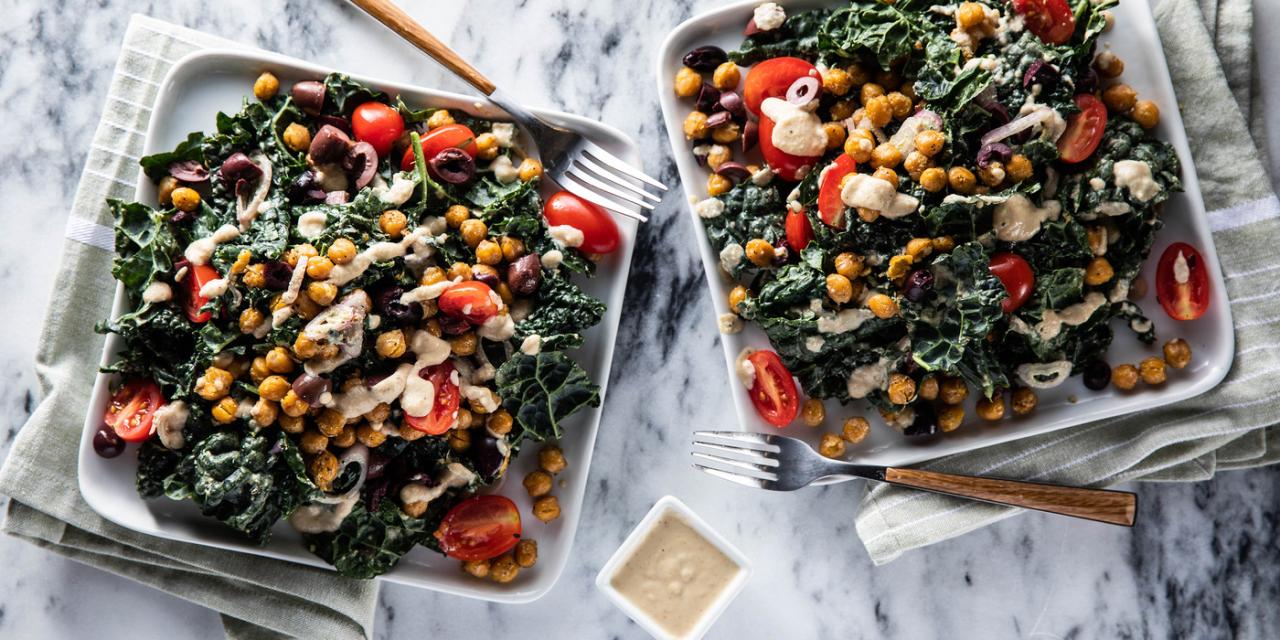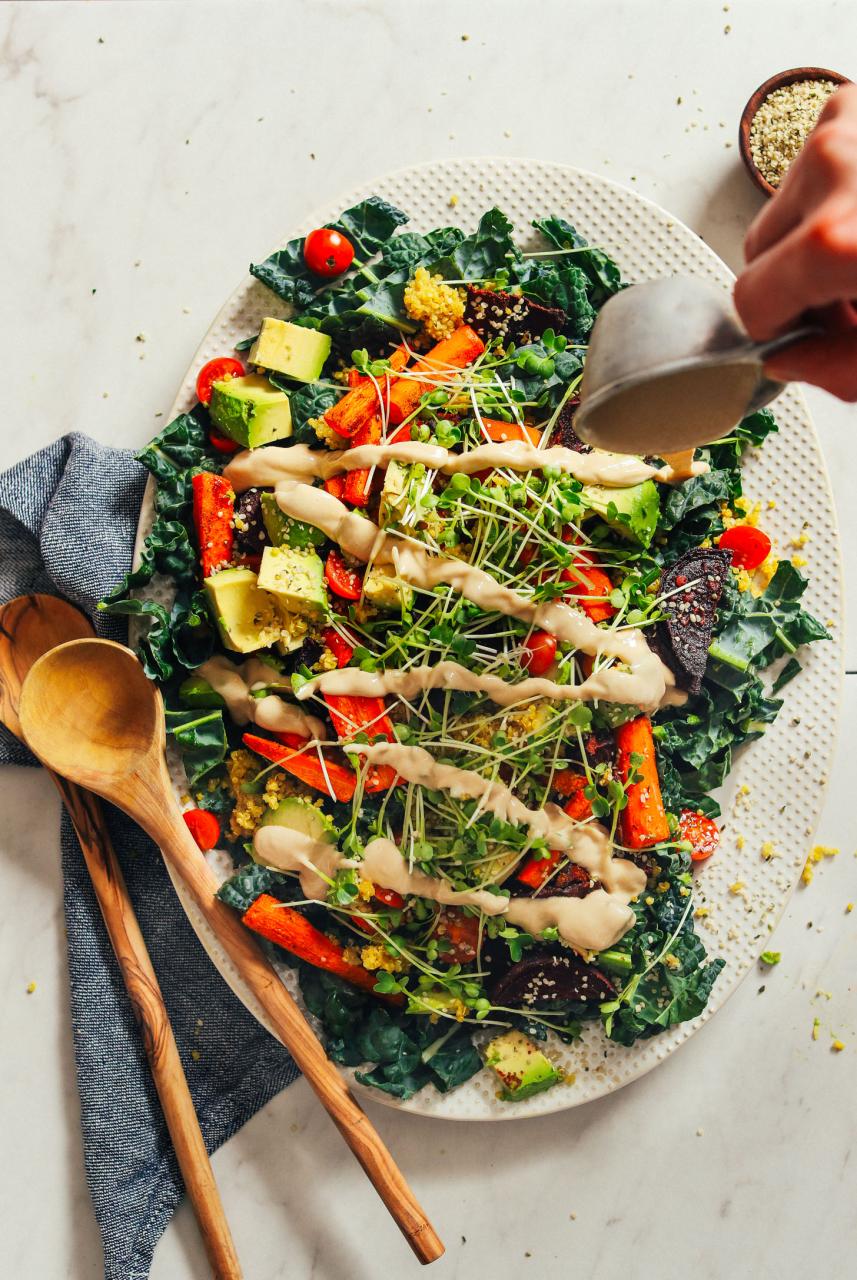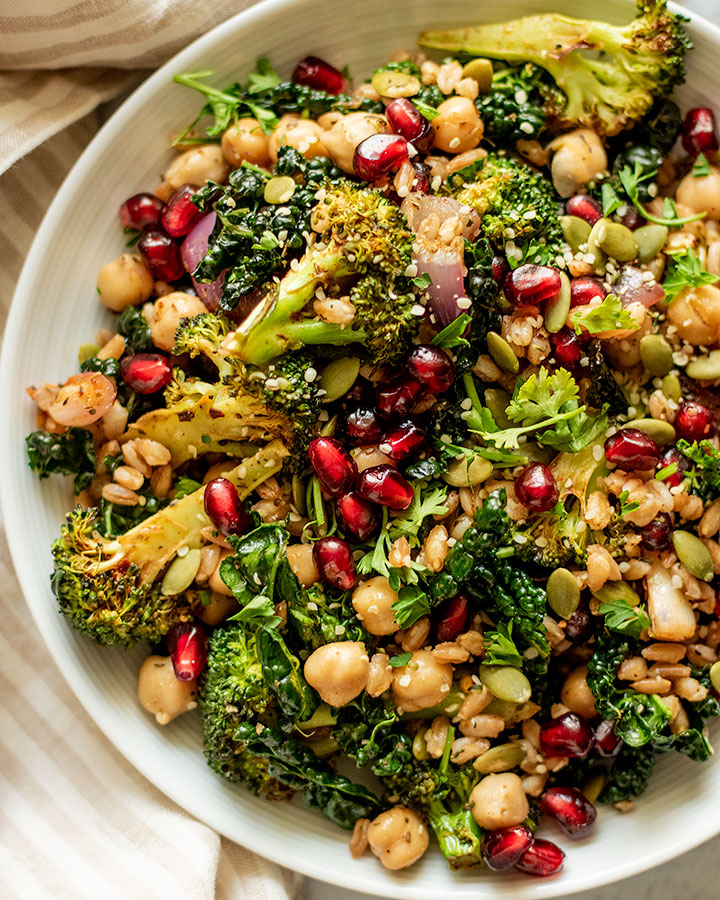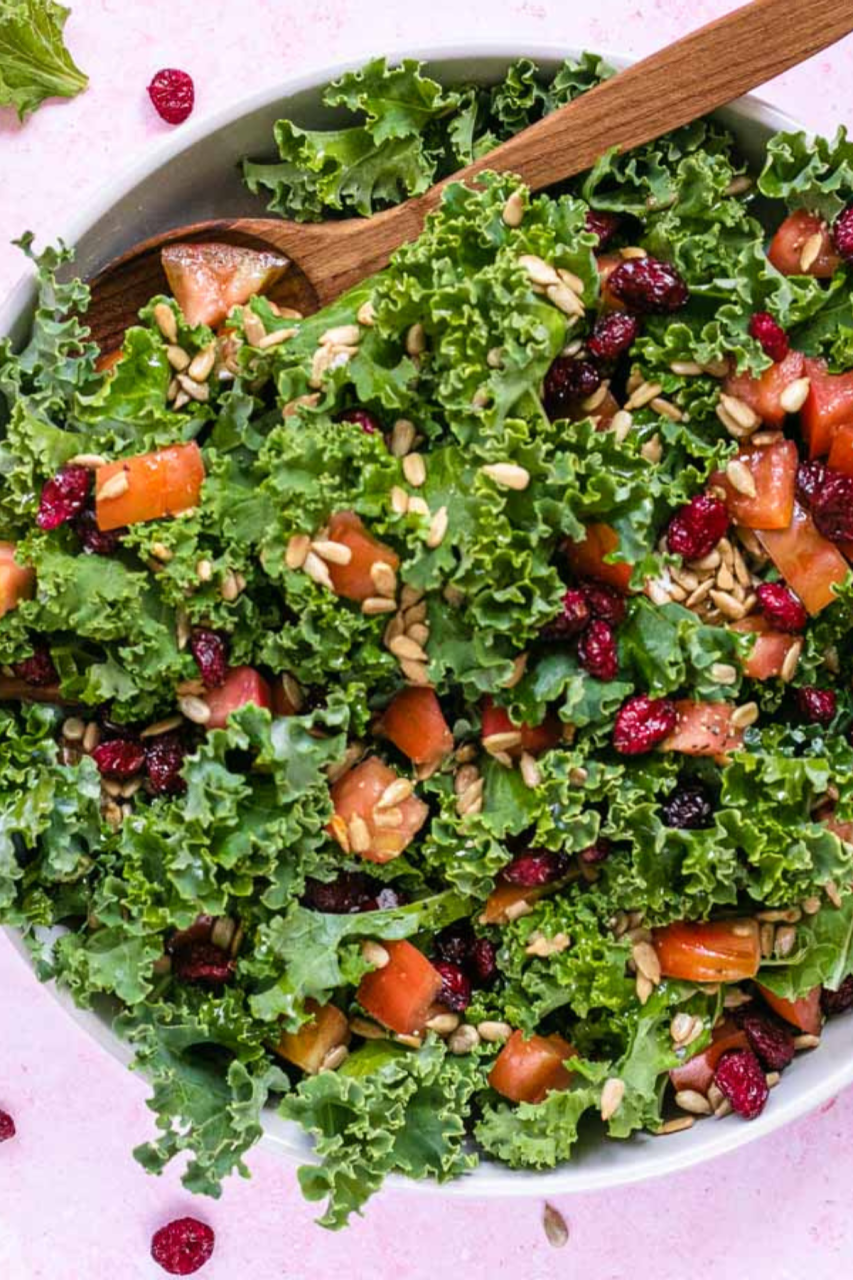A plant-based loaded kale salad can be thought of as a nutrient-rich, highly customizable dish that caters to those looking for a meal that is both healthy and satisfying. Kale, being the central ingredient, is a leafy green vegetable recognized for its nutritional benefits, including high fiber content, vitamins A, K, C, and minerals like calcium and iron. This cruciferous vegetable has gained popularity due to its health benefits and versatility in recipes.
When constructing a loaded kale salad, the focus is on adding a variety of plant-based ingredients that not only complement the taste and texture of kale but also contribute a wide spectrum of nutrients. Common additions might include a colorful array of vegetables such as bell peppers, cherry tomatoes, cucumbers, and red onions, which provide a mix of flavors, crunch, and additional vitamins and antioxidants.
In addition to vegetables, a well-rounded plant-based loaded kale salad might include sources of plant-based protein to make the meal more filling. Options such as chickpeas, black beans, tofu, or tempeh can be added to amplify the protein content while also providing fiber and other essential nutrients. Grains like quinoa or farro can also be included to offer a wholesome carbohydrate component that also contributes protein.
Healthy fats are another essential part of a loaded kale salad. Avocado slices, nuts like almonds or walnuts, and seeds such as pumpkin or sunflower seeds are nutritious options. These not only add texture and flavor but are also rich in unsaturated fats and omega-3 fatty acids, which are beneficial for heart health.
For added flavor and complexity, homemade or store-bought dressings made from plant-based ingredients can be used. These might feature bases like tahini, apple cider vinegar, or lemon juice, and can be seasoned with herbs, garlic, or nutritional yeast to enhance the overall taste profile without relying on animal-based components.
Finally, to address the chewy texture of raw kale, which may be off-putting to some, the leaves can be massaged with a bit of dressing, salt, or lemon juice. This process softens the fibers of the kale and makes it more palatable and easier to digest.
With its combination of diverse ingredients, a plant-based loaded kale salad is emblematic of vibrant health. It exemplifies how plant-based meals can be both nourishing and gourmet, satisfying diners with its layers of flavors and textures while packing a powerful nutritional punch.
Plant-based Loaded Kale Salad Recipe


Plant-based Loaded Kale Salad
Equipment
- 1 small pot
- 1 oven
Ingredients
- For QUINOA
- 3/4 cups quinoa drain and well rinsed
- 1 1/2 cups water
- For VEGETABLES
- 4 large carrots halved and roughly chopped
- 1 whole beet finely sliced
- 2 tbsp water you can also use melted coconut oil or avocado oil
- Kosher salt to taste
- 1/2 tsp curry powder optional
- For DRESSING
- 1/3 cup tahini
- 2-3 tbsp lemon juice
- 1-2 tbsp maple syrup depending on what you want
- 1 pinch sea salt
- 1/4 cup Water to thin
- For SALAD
- 8 cups kale torn or roughly chopped
- 1/2 cup chopped cherry tomatoes
- 1 ripe avocado cubed
- 1/2 cup sprouts of choice optionally, like using broccoli
- 1/4 cup hemp seeds optional
Instructions
- Place the quinoa in a small pot and cook over medium heat and toast for 2 minutes, stir frequently as you roast.
- 2, Add water, cover and reduce heat to low heat and let it simmer until on more liquid, for about 20 minutes. Remove from the heat, uncover, fluff with a fork and set aside.
- Preheat the oven to 375oF and place the beets and carrots in a baking dish. Add water and seasoning of your choice and then toss well to coat.
- Place the baking dish in the oven and roast, until tender and slightly golden brown, for about 30 minutes
- Combine the ingredients of the dressing, tahini, maple syrup, lemon juice, and salt in a small mixing bowl and whisk until smooth and creamy.
- Add water little at a time and whisk until dressing is pourable. Taste and make adjustment to suit your taste
- Place the kale on a serving plate or bowl, top with cooked quinoa, avocado, tomatoes, roasted veggies and any topping of your choice like sprouts or hemp seeds.
- Serve salad immediately with dressing by the side or drizzle on salad and toss until well coated. Enjoy!
- Store any leftover salad and dressing in a separate container and keep in the fridge, use salad within 4 days and dressing within a week
Cooking Tips about Plant-based Loaded Kale Salad

When preparing a plant-based loaded kale salad, there are several considerations that can maximize both the nutritional value and the sensory experience. Kale, being a robust leafy green, can be somewhat tough in texture and slightly bitter in taste, which might be off-putting to some. However, with the appropriate techniques, you can transform it into a delicious and inviting dish.
One important step in preparing kale is to soften its texture. This can be achieved through a process known as ‘massaging’ the kale. Massaging is done by applying a small amount of olive oil, lemon juice, or a vinaigrette and working it into the leaves with your hands. This process breaks down the cell structure, resulting in a softer texture and a less bitter taste.
Another aspect to consider is the balance of flavors and textures in the salad. A variety of elements should be included to create a harmonious dish: something crunchy (such as nuts or seeds), something creamy (avocado or a tahini-based dressing), something sweet (like sliced apple or dried cranberries), and some protein (like chickpeas or black beans). These ingredients not only contribute to the taste but also make the salad more satiating and nutritionally complete.
For added flavor and nutrition, consider incorporating a variety of plant-based toppings. Roasted vegetables like sweet potatoes or brussels sprouts can add depth of flavor, as well as additional nutrients. Grains like quinoa or farro can contribute texture and are an excellent source of plant-based protein.
Lastly, do not forget to season the salad appropriately. Even though it is plant-based, a loaded kale salad still benefits from a broad range of seasonings. Fresh herbs, like parsley or cilantro, can provide bursts of flavor, while spices, such as cumin or coriander, can add warmth and complexity.
Serving suggestions about Plant-based Loaded Kale Salad

- Plating: Choose a large, shallow bowl or a platter that allows you to spread out the ingredients so that they can be seen and mixed easily while eating. Layer the massaged kale at the base and arrange the toppings artfully on top to showcase the variety of colors and textures.
- Garnishes: Add fresh garnishes for an additional pop of color and flavor right before serving. You could use fresh herbs like chopped parsley, cilantro, or dill, or sprinkle some pomegranate seeds or edible flowers for a gourmet touch.
- Serve with Dressing on the Side: Offering the dressing on the side lets guests add the desired amount to their portion, avoiding wilted greens for those who prefer less dressing and ensuring that the kale stays crisp.
- Bread Pairing: Serve the salad with a side of crusty whole-grain bread or herbed flatbread. This adds a hearty component to the meal and provides a delightful contrast in textures.
- Protein Boost: For guests who might want extra protein, consider offering grilled marinated tofu, tempeh slices, or a scoop of hummus on the side which aligns with the plant-based theme.
- Temperature Contrast: While the salad is typically served cold, adding a warm element can be delightful. Consider roasted vegetables that are still warm or grains that have been slightly reheated.
- Dietary Preferences Adaptation: Be mindful of your guests’ dietary preferences or restrictions. Offer alternative dressing options such as nut-free or lower-fat varieties, and label any allergens.
Top 5 FAQs about Plant-based Loaded Kale Salad

- How do you make kale less bitter for a salad? To reduce the bitterness of kale and soften its texture for a salad, it’s recommended to massage the leaves. This can be done by drizzling a small amount of olive oil or lemon juice over the kale and then using your hands to rub the leaves until they become tender and darker in color.
- What are some good plant-based proteins to add to a loaded kale salad? Great plant-based protein options for a loaded kale salad include chickpeas, black beans, lentils, tofu, tempeh, and grains like quinoa or farro. These not only add substantial protein content but also provide fiber and a variety of other nutrients.
- Is it necessary to remove the stems from the kale when making a salad? Yes, it’s generally advised to remove the stems from kale for salads as they can be quite tough and fibrous. The leaves are softer and more pleasant to eat when raw. Simply strip the leaves off the stems before massaging or chopping them.
- Can you prepare a loaded kale salad ahead of time? You can prepare parts of a loaded kale salad ahead of time, such as washing and massaging the kale and preparing the toppings. However, it’s best to dress the salad just before serving to prevent it from becoming soggy. If massaged well, dressed kale can stand up to several hours without wilting too much.
- What type of dressing is best for a plant-based loaded kale salad? For a plant-based loaded kale salad, opt for dressings made with bases such as tahini, avocado, or blended cashews to create a creamy texture without dairy. Enhancing the dressing with lemon juice, apple cider vinegar, herbs, garlic, or nutritional yeast can add depth and complexity to the flavor profile while keeping it vegan-friendly.
In conclusion, a plant-based loaded kale salad is a celebration of healthful, nutrient-rich ingredients assembled into a vibrant and satisfying dish. At its core is the highly nutritious kale, massaged to tender perfection, which serves as a foundation for an array of colorful vegetables, hearty plant proteins, wholesome grains, and healthy fats. This delightful mix not only provides a spectrum of textures and flavors but also makes the meal nutritionally complete and filling.
Leave a Reply